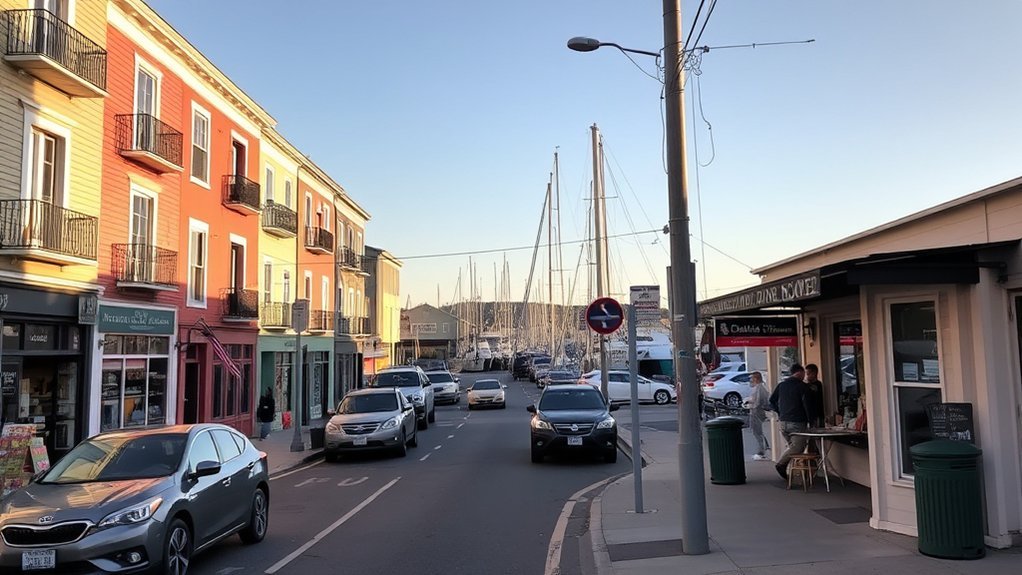You can live modestly in Antigua and Barbuda for about US$960/month, or spend much more depending on housing and utilities, which are the main cost drivers. City rents range from roughly US$370 outside St. John’s to US$740 for a one‑bed downtown; utilities for an 85 m² apartment run near US$290–300. Groceries and local markets offer big savings versus imported goods. Keep going to see detailed budgets, housing and transport trade‑offs.
Overview of Living Costs and Price Index
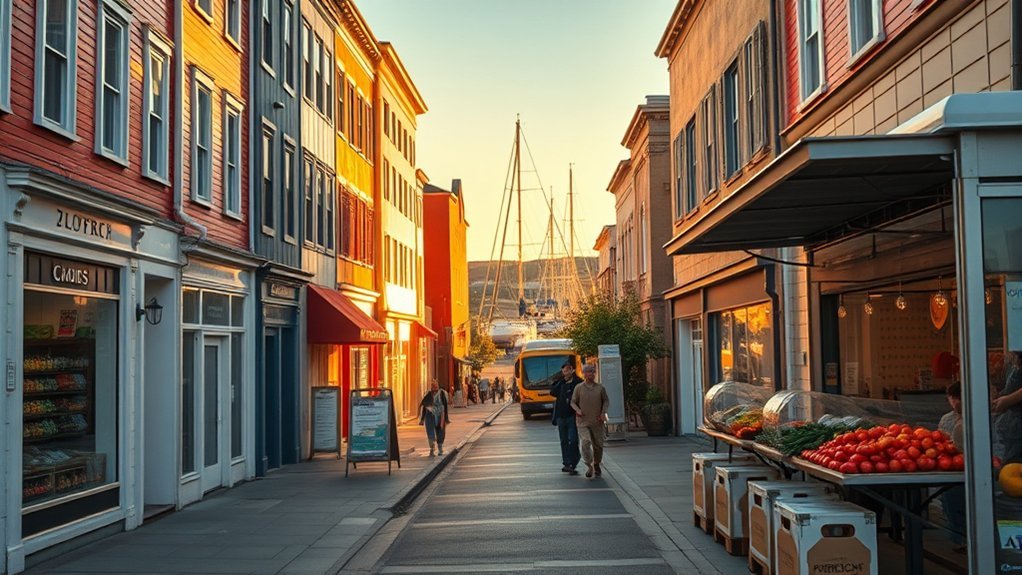
Antigua and Barbuda’s cost of living sits just below the global norm—about 1.01 times less expensive than the world average and ranked 74th of 197 countries—so you’ll find prices broadly comparable to many mid‑range economies.
When you compare city indices (Prague = 100), St. John’s (~1152) and All Saints (~1147) show local variation that pushes some everyday items above global benchmarks.
Numbeo/Expatistan’s averages estimate a family of four at ~EC$12,367/month and a single person at ~EC$5,958/month, though those figures rely on limited data.
Groceries mix cheaper staples (milk 1 L ~EC$6.00) with higher leisure prices (pub beer 500 ml ~EC$8).
Transportation monthly passes vary (~EC$57–$120).
Housing and utilities are the main drivers: basic utilities for an ~85 m² unit run ~US$290–$300/month, and rent differentials markedly affect budgets.
For a cost-conscious comparison, factor in city index and housing exposure when evaluating the average cost of living and overall costs in Antigua.
Housing: Renting and Buying Trends
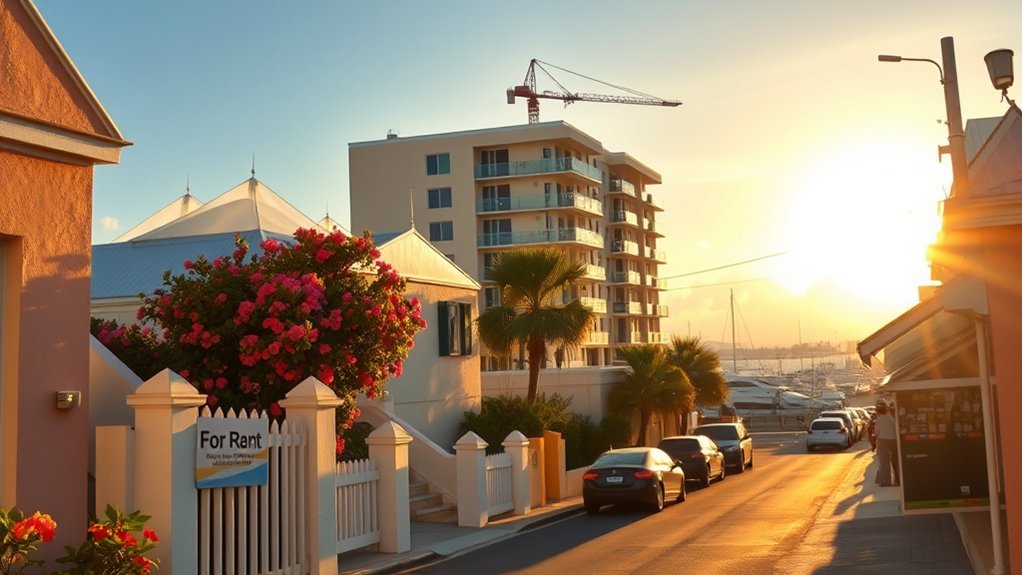
You’ll find one-bedroom rents in St. John’s city center average about $740/month versus roughly $370/month outside the center, while three-bedrooms run ~$1,450–1,455/month centrally and ~$1,110/month outside.
On the purchase side, average prices sit near $1,680/m² with prime and luxury reaching $5,640/m² and $12,560/m² respectively, and typical condo and villa price points ranging from ~$400,000 to $1.5 million.
Expect property values to have grown ~5% annually since 2019, with development-phase projects sometimes appreciating 10–40%, which makes buying a potentially faster route to equity than renting in high-demand areas.
Rental Price Ranges
While rents vary widely by neighborhood and property quality, expect city-center one-bedroom apartments in St. John’s to run about $740 per month, compared with roughly $370 for a one-bedroom apartment outside the city center.
You’ll pay approximately $1,450–$1,455 for a three-bedroom downtown versus about $1,110 outside the center.
Coastal, resort and new developments command significant premiums; rural and non‑tourist neighborhoods are noticeably cheaper.
Average rental levels align with broader property prices—overall residential price per m² is about $1,680, with prime and luxury tiers at $5,640/m² and up to $12,560/m² respectively—so expect market segmentation: midrange rentals in town, value options outside, and high-end inventory concentrated near the coast and amenities.
Purchase Market Trends
Driven by steady annual gains and pronounced segmentation, the purchase market in Antigua and Barbuda is both an investment and lifestyle play you should approach with clear cost expectations.
You’ll see average price per square meter near $1,680, but prime properties sit around $5,640/m² and luxury units can reach $12,560/m², so compare locations carefully.
Property prices have risen about 5% yearly since 2019; development-phase units commonly appreciate 10–20% on completion and some early investors realize ~40% gains.
If you’re considering buying real estate for residency or return, the citizenship by investment program starts at roughly $300,000; one-bedroom condos average $400,000 and villas can hit $1.5M.
Budget accordingly and model upside vs. holding costs.
Utilities, Internet and Household Expenses
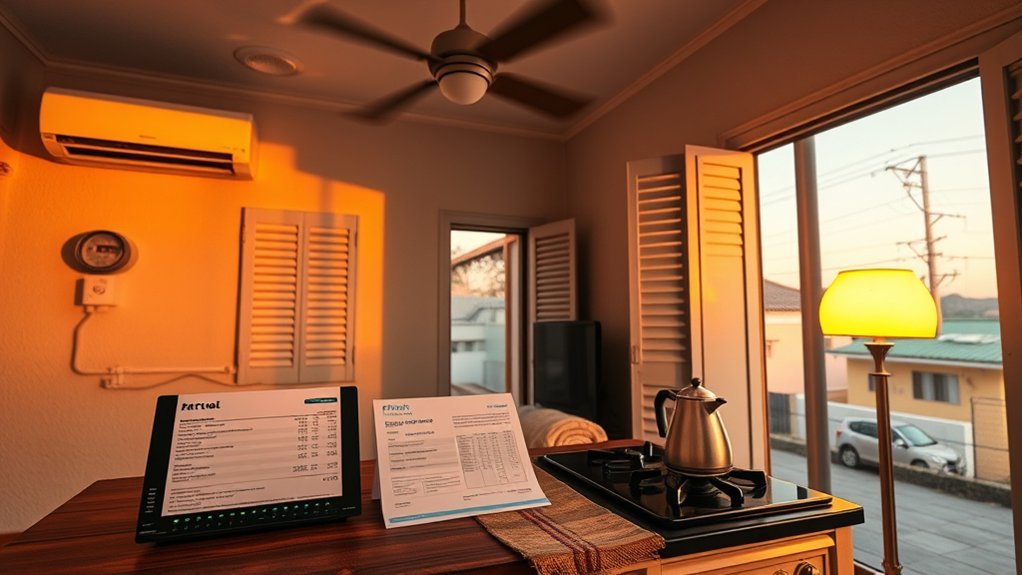
Expect basic utilities for an ~85 m² apartment to run about $290–$300 per month, noticeably above many U.S. averages because electricity is largely petroleum‑generated.
High‑speed internet (50+ Mbps unlimited) typically costs $51–$72 monthly, while a mobile plan averages ~$40 or pay‑as‑you‑go at ~$0.95/min.
Everyday household items are moderately priced—laundry detergent ~$6, toothpaste $2–$5.85, deodorant ~$8—but heavy AC use can push your electricity costs much higher.
Monthly Utility Costs
Because energy comes largely from imported petroleum, your basic utilities for an ~85 m² apartment — electricity, water and garbage — typically run about $290–$300 per month, with electricity accounting for most of that total.
You’ll notice utilities and electricity costs sit above many regional comparators because generation is fuel-intensive.
Expect a separate high-speed internet monthly plan to add roughly $51–$72, depending on speed and provider.
Mobile service averages about $40 for a basic monthly plan; pay-as-you-go calls can be ~$0.95 per minute without discounts.
To cut costs, prioritize airy or seaside unit orientation and efficient cooling to lower electricity use.
Internet Speeds and Prices
When you shop for home internet in Antigua and Barbuda, plan on paying about $51–$72 per month for unlimited high‑speed service (50 Mbps or more), noticeably cheaper than the U.S. average of roughly $66.50; mobile plans run about $40 monthly or pay‑as‑you‑go at ~$0.95/min.
Expect variation: some providers price typical unlimited plans near $51.10, others near $72, so compare packages for peak speeds, caps, and installation.
Factor the monthly cost into your household budget alongside ~$290–$300 in basic utilities, since powering routers adds marginally to bills.
Internet availability is strong in urban vs rural comparisons: St. John’s and resort hubs get reliable high-speed internet, while rural areas may face higher prices, lower speeds, or inconsistent service due to infrastructure and import costs.
Household Supplies & Extras
Plan your monthly household budget around roughly EC$290–EC$300 for basic utilities (electricity, water, garbage) plus EC$100–EC$145 for connectivity if you choose high‑speed home internet and a mobile plan — home broadband (50 Mbps+) runs about EC$102–EC$144/month, while a mobile plan is ~EC$80/month or pay‑as‑you‑go calls at ~EC$1.90/min (prices in Eastern Caribbean dollars; converted roughly from USD figures).
Expect household supplies like 3 L laundry detergent (~EC$6), toothpaste (~EC$5.85) and four rolls of toilet paper (~EC$13). Imported goods drive grocery and supplies costs higher than local alternatives.
Add discretionary items: gym (~EC$160/month) and occasional private doctor visits, which can spike expenses. Track monthly outlays and compare local vs imported options to control your budget.
Grocery Prices and Local Food Markets
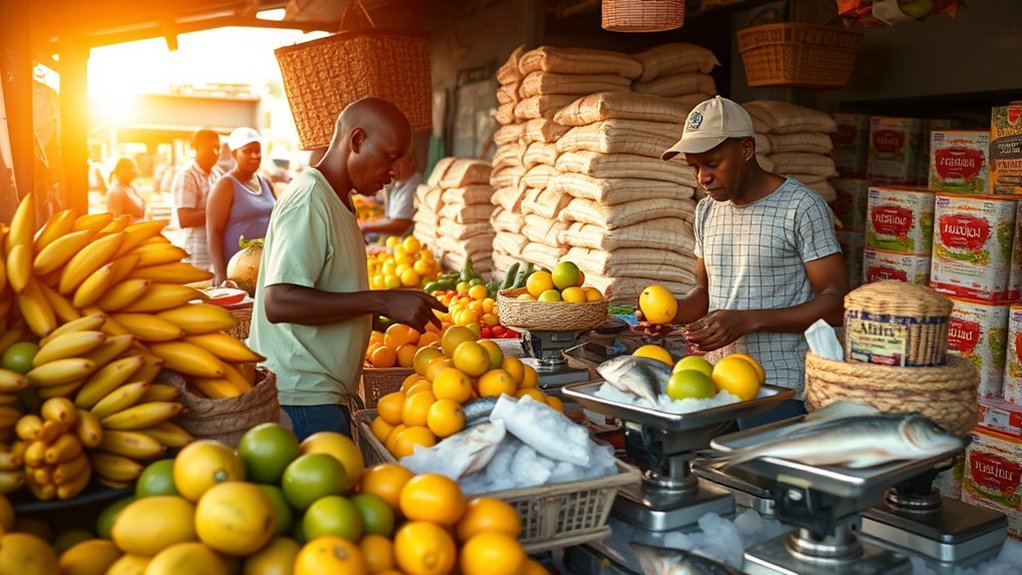
Groceries in Antigua and Barbuda can vary sharply depending on where you shop: buying seasonal fruits and vegetables at local markets will often cost you EC$0.30–EC$2 per item or kilogram and locally grown fruits like bananas, papayas and mangoes typically run about EC$0.70–EC$2 each, whereas supermarket and imported items push prices much higher.
You’ll see milk at about EC$6.00 per liter and a 0.5 kg loaf of bread near EC$2.11, which helps benchmark grocery prices for a moderate basket.
Protein costs differ: chicken breast ≈ EC$8.84/kg, beef ≈ EC$15.40/kg, while fresh seafood often sells for EC$5–EC$10 per pound at docks or markets.
Imported packaged goods drive supermarket totals up—detergent EC$6, toothpaste EC$5.85, toilet paper EC$13. To stretch your budget, prioritize market purchases and seasonal produce.
- Local produce: lowest per-item/kg costs
- Proteins: compare market vs. store
- Seafood: value at local docks
- Dairy & bread: staple benchmarks
- Imports: major price markup
Eating Out, Entertainment and Leisure Costs
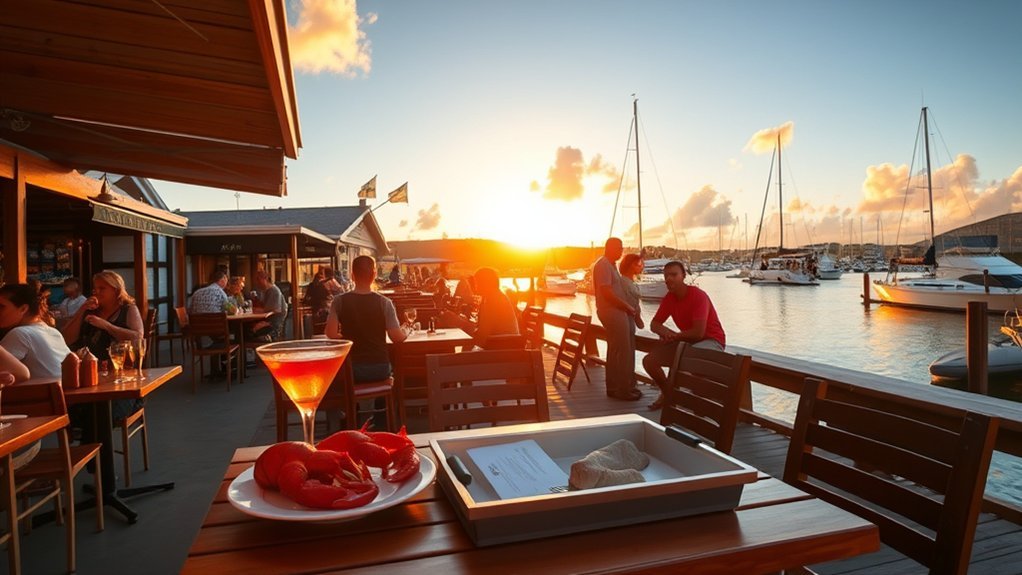
Curious how much you’ll spend on meals and fun in Antigua and Barbuda?
Eating out is relatively affordable compared with many Caribbean Islands: a casual lunch averages $10.40, a fast-food combo runs about $8.05, and a mid-range dinner for two is roughly $53.30. You’ll pay about $3 USD for a pint in a neighbourhood pub (EC$8).
For entertainment and leisure costs, cinema tickets are inexpensive at $6–$7.40, and many beach visits are free or low-cost, keeping everyday recreation cheap.
Tourist excursions like Stingray City typically cost around $50 per person; guided or boat-based activities command higher prices, so budget accordingly if you plan frequent outings. Gym memberships vary from about $44.80 to $160 per month depending on location and amenities.
Transportation, Fuel and Commuting Expenses
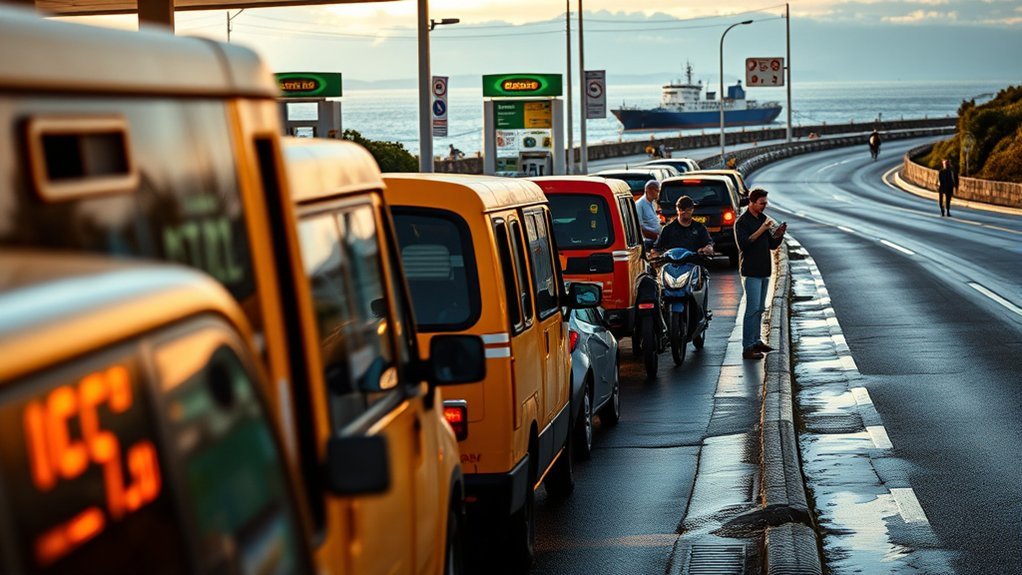
While public transport keeps daily travel cheap, you’ll pay far more if you rely on taxis or drive: a one-way local bus ticket runs about $1.40 (EC$0.93) and monthly passes range roughly $33–$57, but an 8 km (5 mi) taxi averages about $32.70.
You’ll find this makes regular bus commuting vastly more economical than taxis per trip or owning a car.
- Use a public transport pass for predictable monthly costs and lower per-trip rates.
- Compare taxis per trip to bus fares: single taxi ≈ 23× a bus ticket.
- Factor gasoline prices (~$1.12/L or ~$5/gal) into driving budgets; fuel is costly.
- Add vehicle import taxes, VAT (~15%), customs duties (up to ~60%) and levies when estimating purchase costs.
- Account for parking, occasional island taxis and tourist transfers that inflate monthly expenses.
In short, choose public transport where possible; driving or frequent taxis substantially raise your monthly transport budget.
Healthcare, Insurance and Personal Care
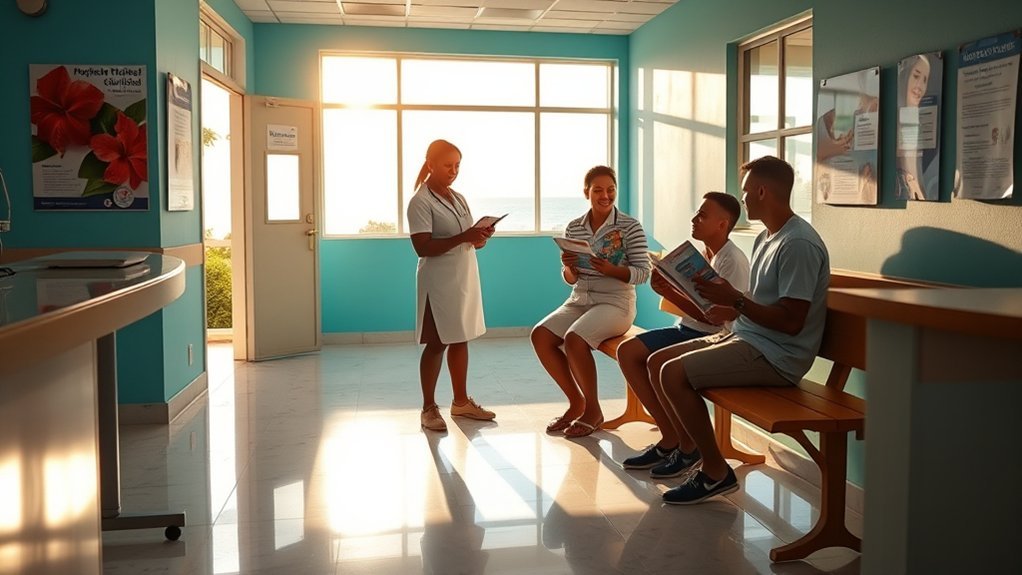
Because public primary care is free under the Medical Benefits Scheme, you can cover basic services at no cost, but most expats choose private providers where a typical doctor visit in St. John’s costs about $40–$80. You’ll weigh lower wait times and perceived quality at private hospitals against out-of-pocket fees: short visits often run EC$150 (~$55), specialists $200–$500. Private health insurance for middle-aged expats typically costs $240–$375/month, which reduces financial risk for procedures or referrals abroad.
| Service | Typical Local Cost (USD) | Notes |
|---|---|---|
| Doctor visit (private) | 40–80 | Short visits often EC$150 (~$55) |
| Specialist visit | 200–500 | Varies by procedure |
| Private health insurance | 240–375/mo | Middle-aged expat premiums |
| OTC cold meds (week) | 8–38 | Brand-dependent |
| Hospital/serious care | Variable | May require referral/medical travel |
Compare insurance premiums to expected out-of-pocket use; if you need specialists or faster access, private health insurance plus private hospitals is cost-effective.
Taxes, Banking and Cost of Doing Business
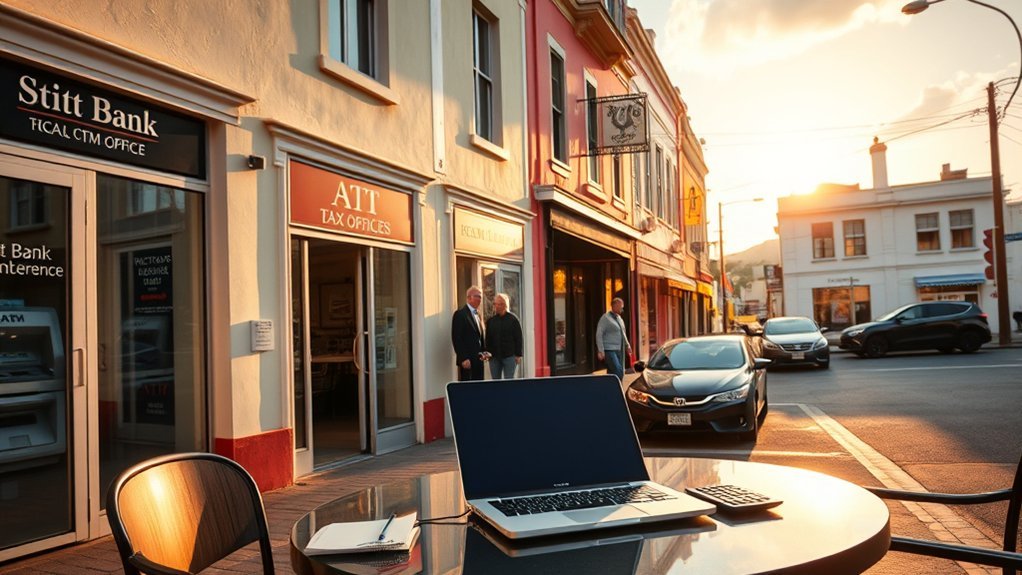
After weighing healthcare choices and insurance costs, you’ll want to take into account how Antigua and Barbuda’s fiscal and banking rules affect your overall budget and business plans. You won’t pay personal income, capital gains, inheritance, or wealth taxes, which lowers living-cost risk and makes the jurisdiction attractive compared with many OECD countries. Corporate incentives target job-creating, foreign-exchange earning industries, so projected effective business tax can be substantially below headline rates if you qualify.
- No personal income or capital gains taxes increases net take-home pay.
- Investment programs can cut corporate rates for qualifying sectors.
- Import duties, VAT (e.g., 15% on vehicle value) and environmental levies raise landed costs.
- Banking involves account and maintenance fees; currency pegged at 2.7 XCD = 1 USD stabilizes exchange exposure.
- Multiple tax information exchange agreements support transparency for international investors.
Factor import duties and banking fees into unit-cost models; compare total landed cost and net profit scenarios before committing.
Money-Saving Tips and Budget Examples
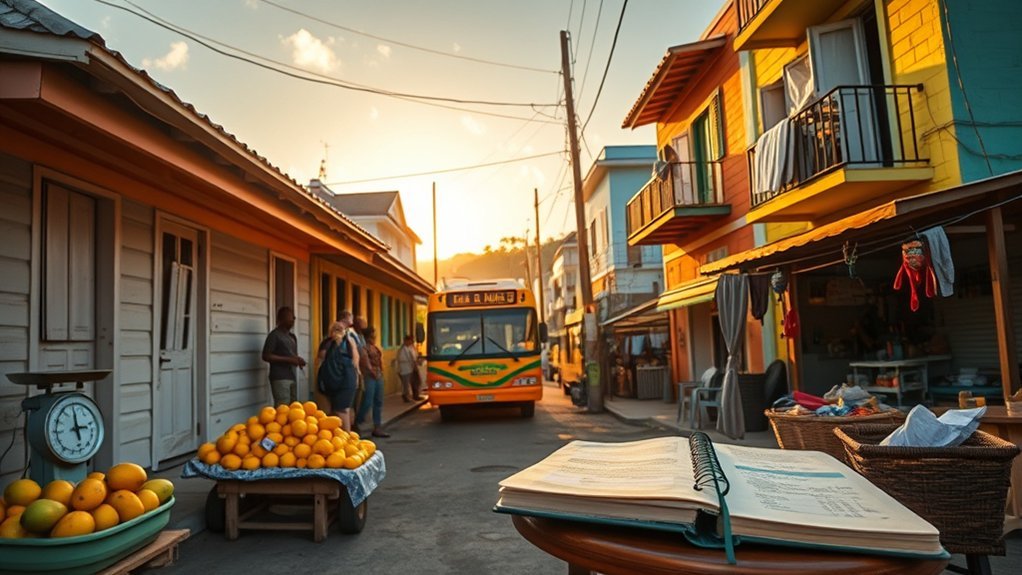
If you want to cut monthly living costs in Antigua and Barbuda, prioritize local markets, off‑center housing, and public transit: switching from a St. John’s center apartment to outside lowers average rent from about $740 to $370/month.
For groceries, buy seasonal produce—bananas, papayas, tomatoes often cost $0.30–$2.00 each versus pricier imports—so your food bill can fall substantially.
Use buses and monthly passes (≈ $33–$57) instead of taxis (an 8 km ride ≈ $32.70) to trim transport expenses.
Limit heavy A/C and pick well‑ventilated or seaside units to keep electricity near $290–$300/month for an ~85 m² apartment.
Cook most meals: mid‑range dinners for two run $53–$92, while Street food and casual local meals cost $2–$20 per person.
Example monthly budget for living in Antigua: rent $370, utilities $290, groceries $150, transport $50 (monthly passes), dining/incidentals $100 — roughly $960/month, a cost‑conscious baseline you can adjust.
Frequently Asked Questions
Can a US Citizen Move to Antigua?
Yes — you can move to Antigua, but you’ll need residency via work permits, long‑term residence applications, or the CBI program (real estate from USD 300,000 or NDF from USD 230,000), so budget accordingly.
How Much Does It Cost to Live in Antigua and Barbuda Compared to the US?
Like a gentle tide lowering bills, you’ll pay about 20% less overall in Antigua and Barbuda than the US. Groceries vary, rent and utilities are generally cheaper, while imported electronics and prime beachfront housing cost more.
What Are the Disadvantages of Living in Antigua and Barbuda?
You’ll face high import-driven prices, pricey rents in tourist areas, costly utilities and transport, limited public healthcare pushing private costs, scarce specialist services and job options outside tourism, and higher overall living expenses versus many countries.
Can a US Citizen Buy a House in Antigua?
Yes — you can buy a house in Antigua; think of it as buying sunshine. Expect prices from roughly USD 300k–400k for qualifying units, varied per m², plus VAT, transfer taxes, legal fees and limited mortgage options.
Conclusion
You’ll see Antigua and Barbuda isn’t cheap — rent, groceries and fuel run conspicuously above regional averages — but costs vary by lifestyle and location. If you prioritize savings, choose local markets, modest rentals and shared transport; if you want convenience, expect 20–50% higher bills. Consider comparing neighborhood rent, utility and grocery data side-by-side before relocating: small choices can cut monthly expenses substantially, turning a pricey island into an affordable home.

